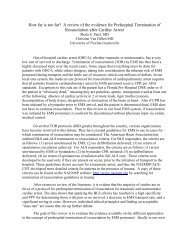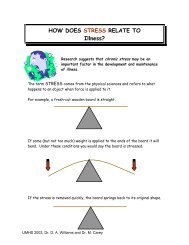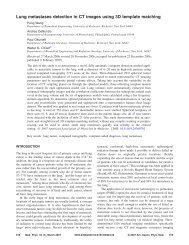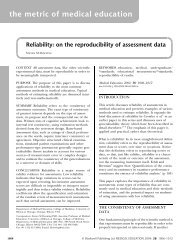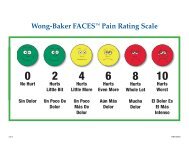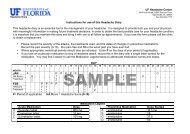imaging three-dimensional cardiac function - Walter G. O'Dell, PhD
imaging three-dimensional cardiac function - Walter G. O'Dell, PhD
imaging three-dimensional cardiac function - Walter G. O'Dell, PhD
You also want an ePaper? Increase the reach of your titles
YUMPU automatically turns print PDFs into web optimized ePapers that Google loves.
Annu. Rev. Biomed. Eng. 2000.2:431-456. Downloaded from arjournals.annualreviews.orgby UNIVERSITY OF ROCHESTER LIBRARY on 07/27/09. For personal use only.?IMAGING 3-D CARDIAC FUNCTION 439of 2.5–3.4 ml or ∼6.2%–8.5% of the total end-systolic volume (for a representativeend-systolic volume of 40 ml). Similarly, it is difficult to detect the most apicalintracavitary point by using only short-axis images. Both of these sources of errorcan be overcome by incorporating planar image data from the orthogonal, long-axisview.When referenced to 3-D ECG and equilibrium radionuclide angiography,limited-plane 2-D ECG methods were no better than subjective visual estimationfor determining the LV ejection fraction (14). To compensate for the inherentlimitations, some applications use correction factors that are calibrated to match theknown volume errors as tested on postmortem or experimental heart models (40).However, these correction factors are computed for a “typical” heart geometry thatmay not necessarily be appropriate for abnormal or diseased hearts.Poor CNRs and partial-volume effects both contribute to errors in the segmentationof heart contour data, which are magnified in the LV volume estimate. Fora sphere of radius 25 mm, a typical LV minor-axis radius dimension, an error of1 mm (4%) in the estimated radius leads to a volume estimation error of ∼12%.All <strong>imaging</strong> modalities suffer misregistration of the heart contour data when theimage data are acquired over many heartbeats or different times, as a result ofbeat-to-beat variations in the heart contraction and uncorrected respiration-derivedmotions. With projection images, the contrast silhouette obscures most of the indentationsin the wall (i.e. at the papillary muscle sites), creating an overestimationof the true ventricular dimensions. A comparison between cross-sectional ECG andX-ray ventriculography found that projection <strong>imaging</strong> leads to an overestimationin ejection fraction of 22% (42).When only a few ventricular surface measurements are available, it is convenientto model the LV surface geometry as an ellipsoid. This simplification allows forrapid calculation of volume but disregards the asymmetry of the actual ventricularsurface, the complexity of the mitral valve plane, and the existence of the papillarymuscles. Elliptical models were initially used with projection ventriculography(40), but are now also used commonly with 2-D ECG data (43). The volume of anellipse is given by:V = 4 3 πab2Surface Modeling with Ellipsoidswhere a is the radius along the major axis and b is the radius of the minor axis.For single-plane projections, Dodge (40) used the formulab = A projπawhere b is the minor axis dimension and A proj is the area of the long-axis projection(making V = 4A2 proj). An analogous formula exists for biplanar data. Ellipsoidal3πa



